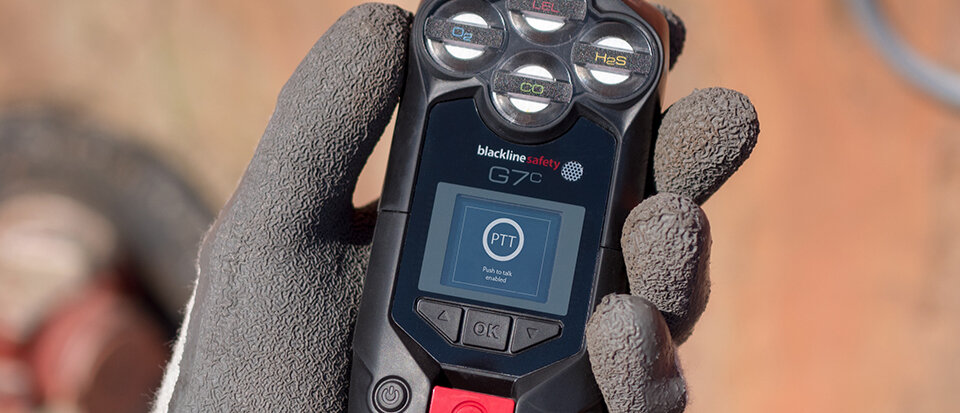Blackline Safety: Live worldwide identification—in 2 seconds, within 5 meters
Imagine this: you’re working alone, trying to repair an electrical connection beneath a deserted city street. It’s dark, it’s cold, it’s nighttime, no one knows exactly where you are—and you slip and hit your head, losing consciousness.
If your company uses Blackline Safety equipment, your fall will trigger a sensor-based alarm and they’ll find you in 2 seconds, pinpointing your location within 5 meters—whether you’re in Calgary or Ulaanbaatar. Your company is alerted. Help arrives. Crisis averted.
More than 53 million people in North America and Europe are “lone workers”—people who work in isolation, with no close supervision. That’s 53 million people at risk for sustaining an injury or accident without anyone else around to help. These people work not just around on city streets but in tanks, pipes, backyards, plants and remote areas, and if they get in trouble, have a health issue, or are otherwise in danger, help can be delayed until it’s too late. Blackline provides these workers and their employers with what they call “the world’s first turn-key, work-anywhere connected safety monitoring solution with gas detection, 3G wireless, two-way speakerphone and live monitoring.”
Blackline Safety’s G7 used at dusk
HOW IT WORKS
Blackline’s tracking technology originated as a vehicle safety and security tracking system; when Blackline was asked if they could also locate workers in trouble, they eagerly pursued the challenge. Other companies had developed a smart phone app, but this approach is problematic: not only does a phone have lots of buttons and touchscreens—which could be overwhelming to a person who is hurt or in trouble—but you can't take a phone into any kind of petrochemical facility because there’s a risk of explosion.
The signature Blackline G7 device features everything a full smartphone has, but it is not used as a phone. (It can’t make calls, although it can receive them and can become a two-way communication device as needed.) The battery-operated device features a 4-channel worldwide cell radio, GPS, telemeters (sensors that indicate motion/falling), a panic button, and a screen reader for gas readings.
Every 5 minutes (or other agreed-upon interval), Blackline’s 24/7 operations portal takes a reading of its cloud-connected devices, identifying the individual carrying that device, the date, time, and GPS location. Blackline also reads each onboard sensor and transmits all this information to the client, via a private encrypted window into the Blackline Live portal. If a device carrier is motionless for 60 seconds, Blackline sends that person a confirm request; if there’s no response within 30 seconds, they escalate the issue. If a company wishes, Blackline’s system can check in with each employee every hour; all people have to do is press a button to respond that all is well. Otherwise, an alarm is issued. An alarm also sounds if a device loses its network connection unexpectedly (i.e., not as a matter of a planned entry into a space with no signal).
The Blackline operations centre is staffed with specialists who are trained to manage safety risks online. Blackline significantly reduces response time and helps emergency responders precisely locate the injured individual, not only outdoors but right down to the building floor and room in which they’re located.
GAS DETECTION: CHANGING RECOVERY TO RESCUE
Let’s go back to the scenario at the beginning of this story. Before you descend underground to perform any kind of maintenance, it would be good know a few things: Is there enough oxygen in there for you? Or are you in the presence of chlorine or ammonia gases, which can corrode the lungs? What about hydrogen sulfide, a poisonous and explosive gas that’s commonly present in sewers (and, for that matter, at drilling sites, wastewater treatment plants and other utility facilities)? In such instances, the good old “do you smell rotten eggs?” test isn’t really good enough, nor is last Tuesday’s site analysis. You need something to indicate definitively whether gases are present, right now, and in what amounts—so that you don’t die or seriously harm yourself.
Blackline’s G7 line is unique in the marketplace, providing real-time gas detection so that workers can go into unknown environments with confidence, and control rooms can monitor employee safety 24/7. Employees can see clearly when their devices are connected and working, so they can undertake dangerous tasks with more confidence. Importantly, the Blackline platform lets management see if the devices are being used properly—providing not just a nod to safety, but actual safety (and some degree of legal protection for an employer). Companies can confirm that everyone is safe, right now, today, and are carrying instruments that are capable of guaranteeing that. The G7 device can also broadcast an SOS in an emergency and provide evacuation management tools. The G7 system, in other words, can transform a recovery response into a rescue response.
“Blackline’s approach to business is to say ‘Yes.” That’s the key to our success.”
CONTACT TRACING DURING THE COVID CRISIS
Blackline is at its heart a safety business—and it has responded to the COVID pandemic with a number of ways for companies to keep their employees safe and contain the spread of the virus. If an employee carrying a Blackline device/app (and there are 60,000 workers in Canada and around the world who are carrying one) tests positive for COVID-19—or even has symptoms—Blackline can help retrace that person's steps to identify coworkers with whom they were in contact.
The company offers two main tools to help companies prevent and contain COVID-19:
The Blackline Analytics Close Contact Report shows how often close contact is taking place, between whom, and the physical locations where that’s happening the most. This tool helps identify spots that invite interactions and can also identify potential super-spreaders who need to be reminded of social distancing expectations. Employers can run customized reports for specific dates and distances.
Blackline devices automatically communicate their wearer’s location to a cloud-based portal called Blackline Live. Using the History view of this dashboard, employers can see up to two weeks’ worth of an individual’s location data. Obviously, this kind of information is invaluable when trying to reconstruct who was where when—and who else was there.
GAME CHANGER
Neil Campbell, Director International Sales & Marketing at Blackline Safety Inc.
There’s a push button on the front of the G7 unit that allows a user to engage an encrypted walkie-talkie function with anyone in the company who also has a unit. This represents a major advance in the technology for a number of reasons. First, anyone can hear a walkie talkie—they're not private. They also have distance limitations; if they’re to be used within big facilities or plants, for example, boosters will be required to make sure that the entire space is covered for use. The Blackline device is digital, which means that repeaters aren't needed.
“Push-to-talk allows you to talk to everybody in your organization at once, in real time, no matter where people are located,” says Campbell. “Each unit has 100 channels; the entire company can be on one channel, but you can also have one-on-ones on another channel—to explain a procedure to a single technician, for example. This has shocked the market—before, companies were spending hundreds of dollars on gas detectors that warn individuals but not the entire company (for example, in the case of an evacuation), and spending thousands more on industrial walkie-talkies. We combine both those things in a single, cost-effective device.”
GOING GLOBAL
As Blackline’s Director of International Sales & Marketing, Campbell has spent years and flown many miles—more than 100K every year for two decades. The company’s international group is not looking to cover the whole world, but targets markets where key industries present significant worker safety issues, such as in Australia, India, Brazil, and Singapore. Blackline’s largest export markets are in the USA and Europe, but they will soon be investigating opportunities in the Middle East, in the nations of the Gulf Cooperation Council and other oil and gas countries in the Arabian Gulf.
Blackline has clients in more than 100 countries, in industries from aerospace to pharmaceuticals to petrochemicals to manufacturing and more. Here are three examples of how this Calgary-based company is keeping people safe around the globe:
Australia: A multinational oil and gas company employs a 7-person team to vehicle patrol a 200km pipeline around the clock. Before engaging Blackline, those people would be alone in remote forests and fields, with no easy way of contacting headquarters in case of danger or mishap. Now, they each carry a monitoring device that detects gases, lack of movement, falls, SOS calls and network disconnect.
Argentina: In Neuquen province’s vast natural gas fields, supervisors across this remote desert area use Blackline’s G7x safety monitoring system to connect to the phone network or to the Iridium Satellite Constellation. The G7x can communicate up to two kilometers away with a portable G7 Bridge base station, ensuring that lone workers in the middle of nowhere remain in real-time contact with monitoring personnel.
Singapore: In a large, multi-story factory, workers carry Blackline units without sensors. Finding people within a building in an emergency situation is difficult because GPS systems typically do not work inside buildings. The Blackline solution is to use beacons that communicate with a worker’s G7C unit to precisely locate that person on a floor plan. First responders are thus able to navigate interior landscapes to quickly locate a person in trouble.
Blackline Safety G7 product line
WHAT’S NEXT
Blackline's new EXO platform—the world’s first direct-to-cloud area gas monitor—is expected to launch in September 2020; it is designed to remain indefinitely at a certain location in a plant or facility and has many applications. It can be moved around as construction or drilling advances to ensure there are no gas leaks. With 4G cellular and satellite connectivity, the device can be solar powered and placed in a remote area to provide a control room with real-time information about stations or pipeline sectors or switches. Most similar devices in the market run for 3-4 days; the EXO runs for an unprecedented 100 days and connects anywhere in the world with a mobile network.




